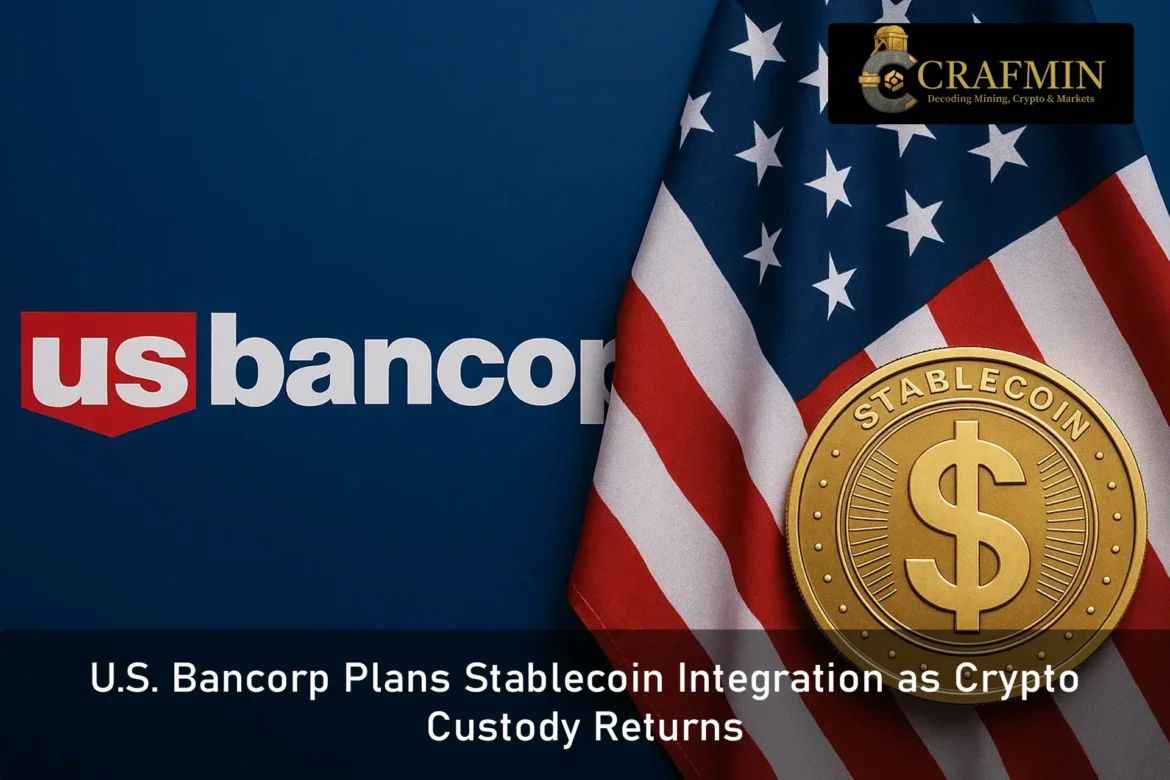U.S. Bancorp is re-entering the digital asset market, with a renewed focus on stablecoin issuance and institutional crypto custody services.
As digital asset adoption among institutions rebounds, the fifth-largest U.S. bank is reportedly reviving its crypto custody operations and exploring infrastructure to support stablecoins. This strategic shift comes amid a more favourable regulatory outlook and rising client demand for secure, bank-grade digital asset services.

U.S. Bancorp revives crypto custody, eyes stablecoin launch ( Image Source: CryptoRank )
Strategic Return to Digital Assets
While many legacy financial firms have approached digital assets with caution, U.S. Bancorp appears to be returning with intent. Insiders suggest the bank is assessing ways to deploy stablecoin solutions for its institutional clients, signalling a broader pivot toward blockchain-powered finance.
Gunjan Kedia, Vice Chair of Wealth, Corporate, Commercial, and Institutional Banking at U.S. Bancorp, underscores the importance of this shift: “Don’t walk away from this space,” she says, echoing sentiments voiced by institutional partners eager for innovative banking tools.
This renewed focus aligns with the growing market appetite for regulated digital asset services—especially as firms look to modernise their treasury operations and cross-border transactions.
Why Stablecoins—and Why Now?
Stablecoins have emerged as one of the most practical applications of blockchain technology, offering the benefits of digital transactions with the stability of fiat currency.
Pegged to assets like the U.S. dollar, stablecoins provide real-time settlements, lower transaction costs, and seamless global payments—making them an attractive proposition for corporate clients navigating increasingly complex financial environments.
U.S. Bancorp’s current exploration suggests that stablecoins could play a central role in liquidity management, cross-border settlements, and even tokenisation of real-world assets. For institutions, the appeal lies in combining blockchain efficiency with predictable value—without the volatility often associated with cryptocurrencies like Bitcoin or Ether.
Resurrecting Crypto Custody
U.S. Bancorp’s digital asset custody service had been placed on hold during last year’s crypto downturn, primarily due to liquidity concerns and regulatory uncertainty. Now, with clearer guidance and growing interest from large clients, the bank is preparing to relaunch its custody offering.
Unlike consumer-facing crypto products, institutional custody focuses on secure storage, compliance, and operational trust—key requirements for firms seeking long-term exposure to digital assets.
According to Kedia, clients aren’t speculating—they’re strategically integrating digital assets into broader financial plans. By reinstating its custody services, U.S. Bancorp aims to provide a compliant and trustworthy gateway into the digital economy.
Treasury Secretary Scott Bessent sees dollar-pegged stablecoins topping $2T as Senate advances key regulation.
U.S. Bancorp revives crypto custody, exploring stablecoins—signaling banks’ growing embrace of digital assets.
GameStop-themed crypto soared 532% after a… pic.twitter.com/SWVtjKRqlU
— Market Machina (@market_machina) June 12, 2025
Joining the Traditional Banking Shift
U.S. Bancorp’s renewed interest in crypto doesn’t exist in isolation. Major competitors like JPMorgan, Fidelity, and BNY Mellon have already established their presence in digital asset services, especially in areas like custody and tokenisation.
What sets U.S. Bancorp apart is its deliberate focus on stablecoins—not just as financial instruments, but as foundational infrastructure. This reflects a more thoughtful, long-term approach that could enable the bank to lead innovation in areas such as tokenised payments and blockchain-based finance.
Rather than merely offering exposure to crypto markets, U.S. Bancorp is positioning itself to help build the rails that support future digital finance.
Also Read: PayPal Expands PYUSD to Stellar Blockchain for Global Payments and Business Financing
Gunjan Kedia’s Measured Optimism
Amid an industry still recovering from a turbulent crypto winter, Kedia’s stance is both cautious and optimistic.
She emphasises a strategy grounded in client demand and robust risk management. “We’re not rushing,” she states. “We’re learning, studying, and building deliberately.”
This measured approach may prove critical in distinguishing enduring digital asset strategies from short-lived experiments. For U.S. Bancorp, it means aligning innovation with regulatory compliance and institutional-grade safeguards.
Implications for the Financial Ecosystem
The bank’s move matters beyond Wall Street.
For institutional clients, it could soon mean access to secure, blockchain-native financial tools backed by a trusted bank. For fintechs and startups, it signals new partnership opportunities with legacy players. And for the broader crypto ecosystem, it’s a sign of legitimacy: stablecoins and custody are not just niche—they’re becoming integral to global finance.
Moreover, for regulators, U.S. Bancorp’s interest serves as a cue that the private sector is ready to innovate within clear legal frameworks—provided the rules are transparent and supportive.
What Comes Next?
Although U.S. Bancorp hasn’t officially announced a stablecoin, its active exploration points to concrete next steps. The bank is laying the foundation for products that could streamline institutional payments, offer programmable financial tools, and even support DeFi interoperability in the long term.
By re-establishing its custody division and assessing stablecoin frameworks, U.S. Bancorp is helping shape how banks engage with digital assets—not as speculative fads, but as integral components of a modern financial system.
Final Word
U.S. Bancorp’s return to the digital asset space—this time centred on stablecoin infrastructure and custody services—marks a significant evolution in traditional finance’s relationship with crypto.
With trusted legacy systems, strong compliance frameworks, and a growing appetite for blockchain innovation, the bank isn’t just joining the digital revolution—it’s preparing to shape its future.

